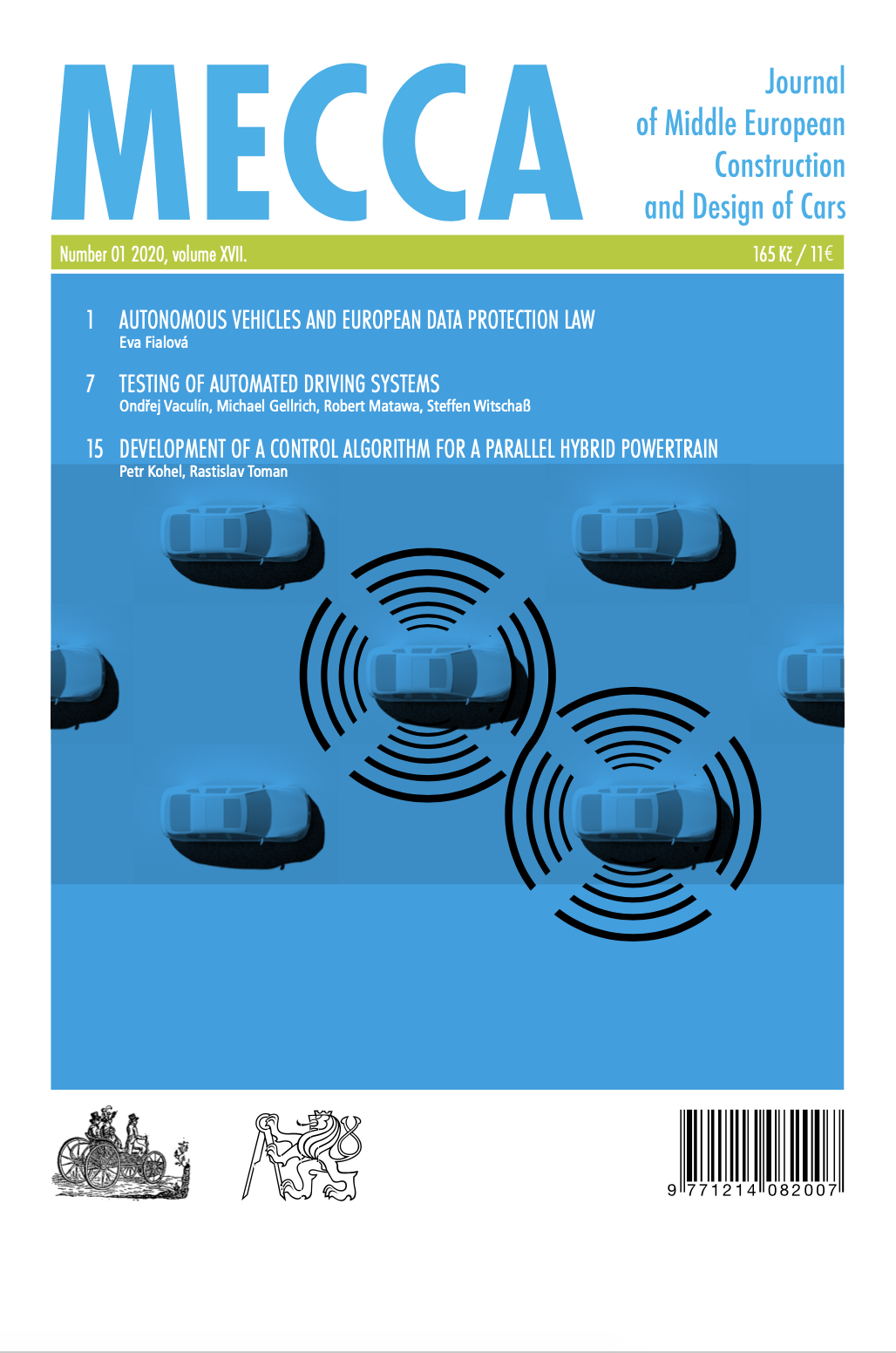AUTONOMOUS VEHICLES AND EUROPEAN DATA PROTECTION LAW
DOI:
https://doi.org/10.14311/mecdc.2020.01.01Keywords:
AUTONOMOUS VEHICLES, DATA PROTECTION, GDPR, PRIVACYAbstract
Autonomous vehicles process a huge amount of data about the driver, or rather passengers of the vehicle, as well as about other persons (pedestrians and passengers of other vehicles). This is why the autonomous vehicles raise questions about the protection of personal data. In 2018 a new European data protection legislation came into force. The General Data Protection Regulation places new obligations on controllers of personal data and provides new rights to data subjects, which will relate to operations of autonomous vehicles and their infrastructure. The providers thereof will have to implement the principles of data protection legislation into their systems. In this context the personal data is not just data concerning the identity of the driver, a passenger or other persons, but any information relating to an identified or identifiable natural person who can be identified, directly or indirectly, in particular by reference to an identifier such as a name, an identification number, location data, or even due to a peculiar behaviour in the vehicle. The paper will focus on the new legal regulation in relation to the operation of autonomous vehicles.
Autonomní vozidla zpracovávají velké množství údajů o řidiči vozidla, resp. cestujících ve vozidle, jakož i o dalších osobách (spolucestujících, chodcích a pasažérech v jiných vozidlech). To je důvod, proč provoz autonomních vozidel vyvolává řadu otázek týkajících se ochrany osobních údajů. V roce 2018 nabyla účinnosti nová evropská právní úprava regulující tuto oblast. Obecné nařízení o ochraně osobních údajů přináší nové povinnosti správcům osobních údajů, jakož i nová práva subjektům údajů, která se budou týkat provozu autonomních vozidel a infrastruktury. Výrobci a poskytovatelé služeb budou muset do svých systémů implementovat legislativu o ochraně osobních údajů. Osobními údaji nejsou pouze údaje týkající se totožnosti řidiče, cestujících nebo jiných osob, ale veškeré informace vztahujících se k identifikované nebo identifikovatelné fyzické osobě, kterou lze přímo nebo nepřímo identifikovat, zejména odkazem na identifikátor, jako je např. název, identifikační číslo, lokalizační údaje, nebo třeba i kvůli osobitému chování ve vozidle. Tento článek se zaměřuje na novou právní úpravu ve vztahu k provozu autonomních vozidel.
References
COLLINGWOOD, L. (2017). Privacy implications and liability issues of autonomous vehicles. Information and Communications Technology Law, vol. 26, no. 1, p. 35.
Judgement of the Court of Justice of the European Union no. Case C582/14 (Patrik Breyer v.Bundesrepublik Deutschland).
European Data Protection Board. Guidelines 2/2019 on the processing of personal data under Article 6(1)(b) GDPR in the context of the provision of online services to data subjects (Version for public consultation). p. 7. Available at: Guidelines 2/2019 on the processing of personal data under Article 6(1)(b) GDPR in the context of the provision of online services to data subjects
GLANCY, D. J. (2012). Privacy in Autonomous Vehicles. Santa Clara Law Review, vol. 52, no. 4, p. 1176.
FRIEDRICH, B. (2015) Verkehrliche Wirkung autonomer Fahrzeuge, in: MAURER, M. et al. Autonomes Fahren, Berlin, Hedelberg: Springer Verlag. 349.
COLLINGWOOD,L.(2017).p.36.
CAVOUKIAN, A. (2012). Operationalizing Privacy by Design:
A Guide to Implementing Strong Privacy Practices, p. 8. Available at: http://www.privacybydesign.ca/content/ uploads/2013/01/operationalizing-pbd-guide.pdf
Verband der Automobilindustr (2014). Data Protection
Principles for Connected Vehicles, p. 3. Available at: https://www.vda.de/de/themen/innovation-und-technik/ vernetzung/datenschutz-prinzipien-fuer-vernetzte-fahrzeug
th International Conference of Data Protection and Privacy Commissioners (2017). Resolution on Data Protection in Automated and Connected Vehicles. Available at: https://www.uoou.cz/assets/File.ashx?id_ org=200144&id_dokumenty=27212
See ePrivacy Tracker. Available at: https://www.eprivacy. law/e-privacy-chronology
STORMS, S. (2018), Quo vadis, ePrivacy? Confidentiality
of machine-to-machine communications. Available at: https://www.law.kuleuven.be/citip/blog/quo-vadis-eprivacy- confidentiality-of-machine-to-machine-communications/
European Automotive and Telecom Alliance (2018).
Data protection & privacy. Available at: https://www.acea. be/uploads/news_documents/EATA_regulatory_briefing_ paper-Data_protection_ePrivacy.pdf
Published
Issue
Section
License
Authors who publish with this journal agree to the following terms:1. Authors retain copyright and grant the journal right of first publication with the work simultaneously licensed under a Creative Commons Attribution License that allows others to share the work with an acknowledgement of the work's authorship and initial publication in this journal.
2. Authors are able to enter into separate, additional contractual arrangements for the non-exclusive distribution of the journal's published version of the work (e.g., post it to an institutional repository or publish it in a book), with an acknowledgement of its initial publication in this journal.
3. Authors are permitted and encouraged to post their work online (e.g., in institutional repositories or on their website) prior to and during the submission process, as it can lead to productive exchanges, as well as earlier and greater citation of published work (See The Effect of Open Access).

